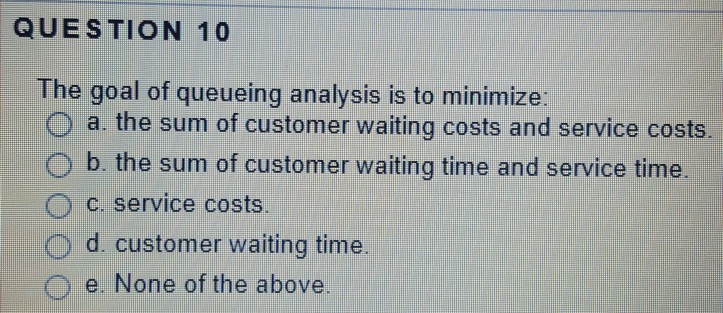The Goal of Queuing Analysis Is to Minimize
The sum of customer waiting time and service time. Capacity costs are the costs of maintaining the ability to provide services.

Solved 18 Which Of The Following Groups Would Not Us N Of Chegg Com
In many cases this will make no substantive difference to the analysis.

. The sum of customer waiting costs and costs of providing capacity. The goal of queuing analysis is to minimize. Thus the waiting line can grow without bound.
The goal of queueing analysis is to minimize. The goal of queueing analysis is to minimize a single. The ultimate goal of.
Customer waiting time4 points QUESTION 2A single server queueing system has an average service time of 8 minutes and an average time between arrivals of 10 minutes. A single server queueing system has an average service time of 7 minutes and an average time between arrivals of 10 minutes. The sum of customer waiting time and service time C.
The goal of queuing analysis is to minimize. The goal of queuing analysis is to minimize the total cost by establishing a capacity level that balances. The sum of customer waiting costs and service costsB.
The order in which customers are processed. Idle servers Minimizing the sum of. 2 True or False True False.
The major objectives of the queuing analysis are to reduce the customer waiting time in the queue and to use the capacity of the organization in the most efficient ways. The sum of customer waiting time and service timeC. Uncontrolled changes to a project is called.
Group of answer choices the sum of customer waiting costs and service costs. Studying congestion and its causes in a process is used to help create more efficient and cost. The sum of customer waiting costs and capacity costs.
Typically reduce the arrival rate proportionally. This preview shows page 8 - 9 out of 9 pages. Costs of providing capacity.
Customer waiting time E. Queuing theory is basically a mathematical approach applied to the analysis of waiting lines within the field of operations management Nosek and Wilson 2001. True or False True False The number of customers in a system is the number in the queue plus one.
The sum of customer waiting costs and capacity costs A basic difference between infinite source and finite source queuing models is. The sum of customer waiting costs and capacity costs B. QUESTION 1The goal of queueing analysis is to minimizeA.
Those associate with capacity. Poisson distribution Which of the following is not one of the four measures typically used to evaluate. The number of servers service cost.
The sum of customer waiting time and service time. Organizations carry out queuing analysis to ensure that they are able to balance the service levels with costs which the organization can incur. In practice any queue is finite.
Those associate with customers waiting for service and. The goal of queuing analysis is to minimize. None of the answer choices is correct.
The sum of customer waiting costs and service costs. The sum of customer waiting time and service time. The term queue discipline refers to.
Cost of service capacity and the cost of customers waiting The most commonly used mathematically model customer arrival rates ie. Both these objectives result in a significant decrease in the capacity cost for the organization and the waiting cost for the customer. The objective of queuing analysis and its application in organizations is to minimize costs to the organization- both tangible and intangible and increase employee.
Number of arrivals per unit of time is. Typically we assume an infinite queue size. Examples include the number of bays at a carwash the number of checkouts at a.
The goal of queuing analysis is to balance the cost of providing a level of service capacity with the possible loss of business due to customers leaving the line or refusing to wait. The sum of customer waiting time and service time. With a finite queue it is possible for items to be lost from the system.
The goal of queueing analysis is to minimize. Gradual long-term movement in time-series values is called. The goal of queuing is essentially to minimize total costs The two basic categories of cost in a queuing situation are.
Operations Management questions and answers. The goal of queuing analysis is to minimize the cost of customers having to wait False A multiple server system assumes that each server will have its own waiting line. The goal of queuing analysis is to minimize customer waiting lines.
Queuing theory is the study of the movement of people objects or information through a line. The goal of queueing analysis is to minimize. The goal of queuing analysis is to minimize.
The sum of customer IMG_20211210_201743jpg - 4. The goal of queuing analysis is to minimize.

Solved The Goal Of Queuing Analysis Is To Help Eliminate Chegg Com

Solved The Goal Of Queuing Analysis Is To Minimize Customer Chegg Com

Solved Question 10 The Goal Of Queueing Analysis Is To Chegg Com
No comments for "The Goal of Queuing Analysis Is to Minimize"
Post a Comment